Marilyn was a comic aimed at young women that ran for over ten years and presented its readers with comic-strips, prose fiction and articles all based around love and romance.
The title, presumably, was chosen to imply an association with Marilyn Monroe: the comic was launched in 1955 shortly after Ms Monroe became massively famous.
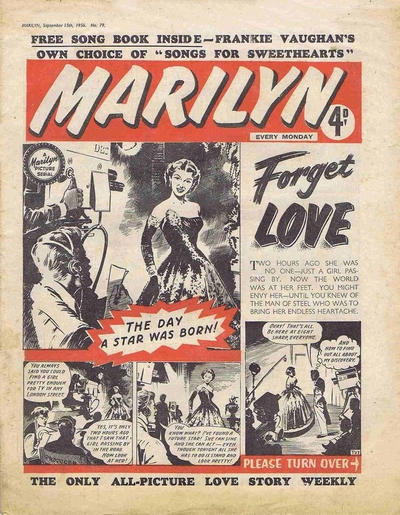
Marilyn (Amalgamated Press)
First issue: 19 March 1955
Last issue: 18 September 1965
Duration: 10 years, 6 months
Issues: 547
Absorbed into: Valentine
Romance comics were the in-thing for a while, with titles like Cherie, Marty, Mirabelle, Romeo, Roxy, Serenade and Valentine also gracing the shelves, not to mention lots of digest comics of the “Picture Library” format — which were small enough for a young lady to hide in her pocket so that her friends didn’t see her reading comics.
When I say “young lady” that’s not just me trying to avoid referring to women as “girls”: many of the elements of the comic are clearly addressing married women too.
The romance comics phase faded around the time printing technology evolved to permit the easier reproduction of photographs: why would a young lady want to read a hand-drawn comic when she could instead be pouring over a magazine with photos of Elvis Presley or David Essex or Shaun Cassidy or David Bowie or Michael Praed or Harrison Ford? Okay, there’s a possibility I’m mixing up eras here: these names come from Mrs Rusty’s list of heartthrobs, none of whom resemble Mrs Rusty’s husband in the slightest (and how come “Heart-throb” was never used as a title for one of these comics?).
Now, I’m clearly not the intended audience for this title: my lifetime and the comic’s lifetime didn’t even overlap. Nevertheless, I shall bravely delve into an issue and do my best to give it a fair and honest review. And people say that chivalry is dead! (“Chivalry” — there’s another potentially awesome title they never used for a romance comic.)
(Truth is, readers, I’m not entirely unqualified to review this comic because I used to write romance novels for a living. That was hard work, but great fun — and a very valuable learning experience.)
Today we’re looking at Marilyn issue #186, cover-dated October 4th 1958 (which, as I’m sure you all know, was exactly one year after Sputnik was launched).

The comic is 230mm by 310mm, thirty-two pages in black and white (except for the spot-colouring on the cover). This is what the whole issue looks like in teeny-tiny “I-don’t-know-how-you-expect-us-to-be-able-to-read-that” mode:
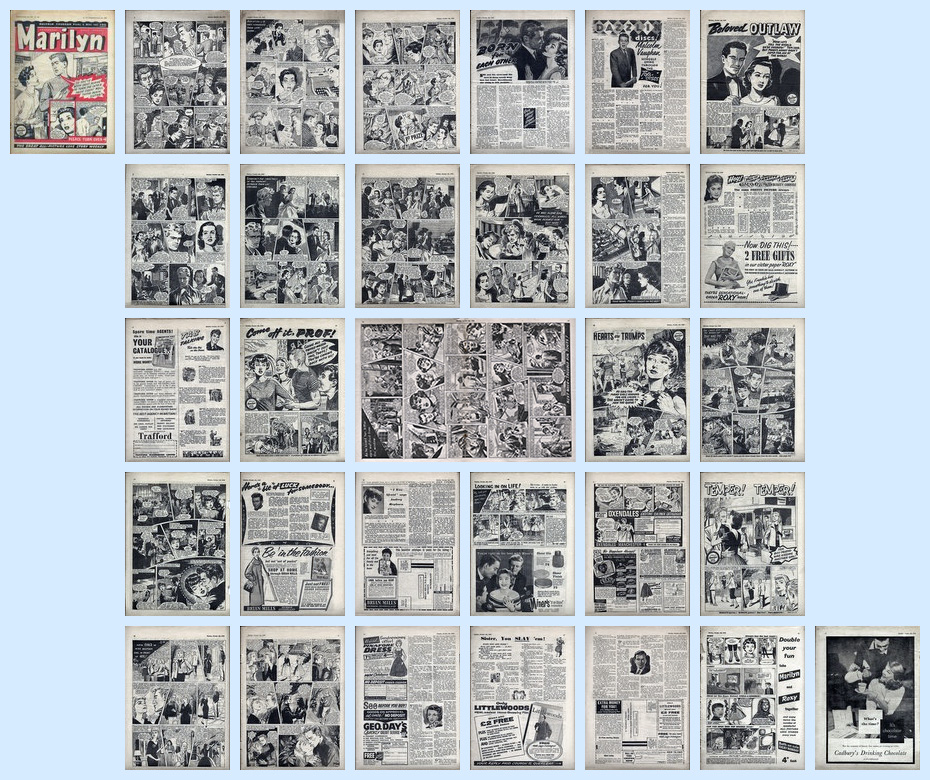
1. Front cover
“All-Picture Love Story Weekly,” eh? Well, that’s a giant blinkin’ fib for a start, as we’ll soon see.
1-4. Untitled Cover Story — comic strip
This four-page one-off tale (tagged as “Complete Marilyn Love Story”) introduces us to Fay and Rod just moments after the former has informed the latter (a relative newcomer to the area) that he’s been selected to play the part of Prince Charming in the social club’s town pageant: the previous Prince Charming has left and Rod’s the only one the costume will fit. However, Rod’s not enamoured of the idea of having to wear the fancy, frilly costume because he’s a manly man, and storms off to play manly sportsball… at which point Fay informs him that if he refuses the social club will deny his sportsball team access to their clubhouse.
 Interrupting the story on page 2 is the caption on the right. That’s product placement, folks, in a 1958 comic. I don’t approve, even though I secretly doff my cap to the genius who came up with the idea.
Interrupting the story on page 2 is the caption on the right. That’s product placement, folks, in a 1958 comic. I don’t approve, even though I secretly doff my cap to the genius who came up with the idea.
Right out of the gate this comic has caught me out by having the first strip defy my expectations (and prejudices). It’s actually far less saccharine and predictable than I’d expected: in the end, neither of the protagonists has to really compromise themselves in order for love to blossom. The artwork is pretty strong, too: great characterisation, dynamic poses that are still pretty natural. Good stuff!
5-6, 12, 28, 30. “Born for Each Other” — text story
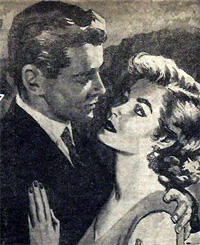 Running throughout this issue is this chapter of an ongoing story of Sally Grant, a chauffeuse for a wealthy couple living in Spain. “Chauffeuse” is an archaic word meaning “female chauffeur” — it’s not a surprise to find such a word in a story published in the 1950s, because in those days if a woman did a job then the title of the job was given a feminine twist just in case anyone got the wrong idea and assumed it was being done by a man. While “chauffeuse” and “air hostess” and “doctress” and other similarly weighted job titles have thankfully faded from general use, we still have a long way to go. “Actress,” for example, is still hanging on.
Running throughout this issue is this chapter of an ongoing story of Sally Grant, a chauffeuse for a wealthy couple living in Spain. “Chauffeuse” is an archaic word meaning “female chauffeur” — it’s not a surprise to find such a word in a story published in the 1950s, because in those days if a woman did a job then the title of the job was given a feminine twist just in case anyone got the wrong idea and assumed it was being done by a man. While “chauffeuse” and “air hostess” and “doctress” and other similarly weighted job titles have thankfully faded from general use, we still have a long way to go. “Actress,” for example, is still hanging on.
But back to the story: I didn’t read it, so I don’t know much about it. I did, however, measure the columns it occupies in the comic and they come to about 1900mm. A sample column of 130mm contains 267 words, so from that we can surmise that the ratio of words to millimetres is 0.4868913857677903. Heck, we’re friends: let’s round that baby up to a nice even 0.49! We divide 1900mm by 0.49 and that tells us there’s about 3,877 words in this chapter.
6. Dazzlin’ Discs! — feature
“Malcolm Vaughan himself spins through the Top discs for you!” it says here. I don’t know who he is, but he opens the column by saying, “Hullo” with a U so that automatically puts me on my guard, and later on he cheerfully says, “P’raps” so now I’m smiling politely as I calmly slide my hand towards the panic button.
The recipients of a mention in this column include Lonnie Donegan, Max Bygraves, The Beavers, Cliff Richard, The Drifters, Cannibal Corpse, Chuck Berry and Pat Boone. I am lying about one of those acts, but can you guess which one?
7-12. “Beloved Outlaw” — comic strip
This one is tagged “A Marilyn Picture Serial.” Mary is a schoolteacher in a small Welsh mining town — in Wales, I suspect, though it doesn’t say — where she meets Glyn Davis, who has a bit of a bad reputation. She’s warned against Glyn by Tom, the headmaster of her school, who is in love with her. However, Glyn is a talented artist and Mary gives him lessons, and finds herself drawn to him (no pun unintended)… Also however, Glyn’s a bit of a jerk: arrogant, argumentative and unappreciative, although we’re told he has been trying to change his ways.
As this episode opens, Tom has just proposed to Mary and she’s accepted — even though she’s not sure she’s doing the right thing. At a local dance, Glyn confronts Mary and then storms off when she says she can no longer teach him. He thinks that this is because she doesn’t want to teach him, but the truth is his skills have surpassed hers. In a huff and a bad mood, Glyn gets hammered and starts a fight (which sadly we don’t get to see), and this results in him being arrested.
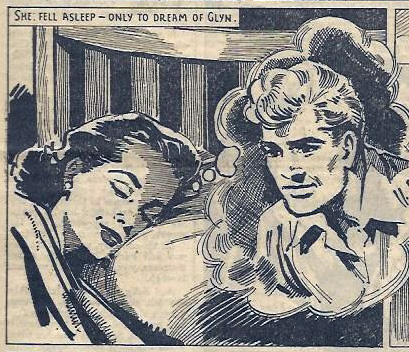
I’m not 100% crazy about the art with this one, for the most part, but there are a few very strong panels, and I rather like the story. Glyn seems like one of those lads who does his best but he just can’t shake his reputation as a “bad boy” — tch, I know what that’s like, believe me.
12. “Born for Each Other” — continued from page 6.
As with page six, this is just a single column of the story tucked away at the edge of the page.
13. Hey! This is Janette Scott’s Gay Time Beauty Corner! — feature
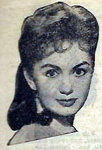 A half-page feature. Janette Scott is an actor who starred in movies such as School for Scoundrels and The Devil’s Disciple, but who’s probably better-known to geeks like me because of The Day of the Triffids and as one of the people name-checked in the opening song from The Rocky Horror Show.
A half-page feature. Janette Scott is an actor who starred in movies such as School for Scoundrels and The Devil’s Disciple, but who’s probably better-known to geeks like me because of The Day of the Triffids and as one of the people name-checked in the opening song from The Rocky Horror Show.
In this column, Janette talks about attending the Venice Film Festival, the importance of wearing appropriate clothes, and the importance of making sure you look attractive at all times, just in case: “When you feel tired and fed-up, because nobody seems to be around, try still harder to be attractive all the time. You’ll be lovelier — and ready to meet Mr Right whenever he puts in an appearance.”
Also on this page is a half-page in-house ad: there are two free gifts in upcoming issues of Marilyn‘s sibling comic Roxy, and it informs us that, “Yes, Frankie has something to do with one of them!” I suspect that they could be referring to debonair actor and known heart-throb Frankie Vaughan because there’s a photo of a top-hat, cane and evening gloves, plus he’s name-checked in Janette Scott’s column, and he appeared in the Marilyn Monroe movie Let’s Make Love (though that last one’s not very likely to be a reason given that the movie didn’t go into production until early 1960, more than a year after this issue was published).
14. Tab Talking — feature
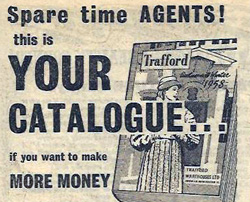 The left half of this page is an ad trying to recruit sellers for the Trafford catalogue. For a brief moment I thought it said “space-time agents” — I’d already eagerly popped off the top of my good form-fillin’ pen before I realised my mistake.
The left half of this page is an ad trying to recruit sellers for the Trafford catalogue. For a brief moment I thought it said “space-time agents” — I’d already eagerly popped off the top of my good form-fillin’ pen before I realised my mistake.
Clothing catalogues were a big thing back in the post-WWII era: this was when rationing had (mostly) ended, there was more money around, and the concept of the teenager had just been born.
The remaining half of the page is taken up with the Tab Talking feature, which tells us: “Tab’s the guy on the ball. Tab knows what’s what. Tab’s wise on the platters, and really digs what the guys like about the gals, too. Follow Tab and you’ve got the gen.” Need I say more?
Yes, I think I do need, actually: Tab tells us about receiving free tickets to a play by the local Drama Group and then being roped in to join said group. Wow, you’ve sure got your finger on the pulse of the youth there, Tab.
Also… “Tab”? Really? What’s that short for? Tabert? Tabasco? Tabraska? Tabernacle?
15-17. “Come Off It, Prof!” — comic strip
This is a “Complete Marilyn Love Story” according to the little stamp in the corner of the first panel… However, the presence of a lengthy recap paragraph suggests otherwise. Toots Lawson is a formerly feral seventeen-year-old orphan who’s recently been taken in by an aunt who works as a housekeeper for Stephen Dudley, a music professor.
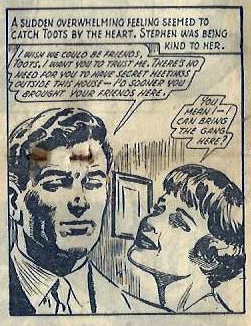 Some of Toots’ old pals from her days running wild on the streets of Rotherpool (about forty metric miles south-west-north of Melchester; twinned with Holby) turn up and she goes off with them — and even kisses her pal Lennie, who appears to be a bit of a wild sort himself. But Toots secretly loves Stephen, and so she tries harder to put her past behind her in order to win his affections.
Some of Toots’ old pals from her days running wild on the streets of Rotherpool (about forty metric miles south-west-north of Melchester; twinned with Holby) turn up and she goes off with them — and even kisses her pal Lennie, who appears to be a bit of a wild sort himself. But Toots secretly loves Stephen, and so she tries harder to put her past behind her in order to win his affections.
I’m not sure about this one. Toots is only seventeen and clearly vulnerable. What’s the youngest someone can become a professor? Hmm. He doesn’t look like he’s an appropriate age for her. Sure, Toots is clearly a good-hearted person because she can see past his disfigurement (he has staples in his forehead) but even so. The art is generally pretty good — and I do like the double-page spread — but the story makes me uncomfortable.
18-20. “Hearts are Trumps” — comic strip
This one is a “Complete Marilyn Love Story.” Joyce is a young woman relaxing on the beach when she inadvertently snags the attention of young fellow-me-lad Jim, who’s been playing a game of sports nearby with a few friends. Jim’s smitten with Joyce but she’s a loner and declines his offer of joining in with the sports game. However, she does accept his offer of a date: he’s the manager of the “show at the variety theatre” and suggests she could join him there. When she arrives, he’s busy with the show and she ends up sitting among a bunch of somewhat aggressively enthusiastic young men (one of them suggests that the “pretty girl” might be a present from the management, which is just creepy). Needless to say, it all works out and Joyce and Jim fall in love. Sweet stuff, mostly, but at only three pages there’s not a lot of room for depth.
21. “Here’s a Bit of Luck for Somebody…”
I know that a lot of people believe in horoscopes, but then a lot of people believe they have lucky socks or that you shouldn’t say the word “Macbeth” inside a theatre (which made our school production of that play very tough work indeed… but I do recall that the girl who played Lady The Scottish Play was very good).
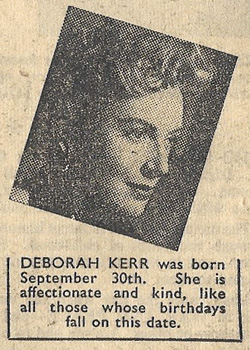 The entire concept of a horoscope just doesn’t make any sense to me. If it were real, then according to this, back in the week leading up to October 4th, 1958, an entire twelfth of the human population (those born between 21 April and 21 May inclusively) will have found that “A new acquaintance could be made.” Pfff!
The entire concept of a horoscope just doesn’t make any sense to me. If it were real, then according to this, back in the week leading up to October 4th, 1958, an entire twelfth of the human population (those born between 21 April and 21 May inclusively) will have found that “A new acquaintance could be made.” Pfff!
The statement on the right about Deborah Kerr’s birthday is clearly ludicrous and of course I wasn’t about to let it go unchallenged… but even after spending far too long searching I still couldn’t find a single murderer or dictator who was born on September 30th. (In case you’re wondering: Fred West’s birthday is September 29th, and Agustin Vasquez-Mendoza’s is October 1st. So close!)
An interesting aspect of the horoscopes in this issue of Marilyn is that they all have separate “readings” for single and married women:
PISCES (Feb. 20 — Mar. 20). SUNNY conditions all the time for the single. Lots of pleasant things happen and romantic plans begin to take shape. If married, some of your hunches are proved unsound.
The remainder of page 21 is filled with another catalogue ad: “Be ‘in the Fashion’ but not ‘out of pocket'” it says, and suggests that we “Shop at home through Brian Mills.”
22. “The Page Where You Always Find a Friend”
A half-page advice column by Joan Courage. According to the opening blurb, every week Ms Courage brings us a true story about a star — in this case, Audrey Hepburn — who’s “known grief and heartbreak,” thus proving that they really are just like the rest of us (only prettier and with more money — well, she doesn’t say that, but we all know it’s true). It’s actually a rather clever idea, I reckon, because it humanises the celebrities and helps the readers at the same time. Ms Courage also doles out specific advice to readers who have written in. One wants to know the address of a Ricky Nelson fan club, another is trying to write to Tony Curtis. And then there’s this:
It’s easy to scoff at advice columns in teenage girls’ magazines and comics, but while the above might not have been a response to a real letter, it was certainly a very real situation for some readers.
The bottom half of the page is the reverse side of the ad for the Brian Mills Catalogue: this one contains the send-away coupon. See, this way you don’t have to lose any of the important parts of your comic when you clip the coupon!
23. “Looking in on Life”
Another half-page advice column, this time in comic-strip form… 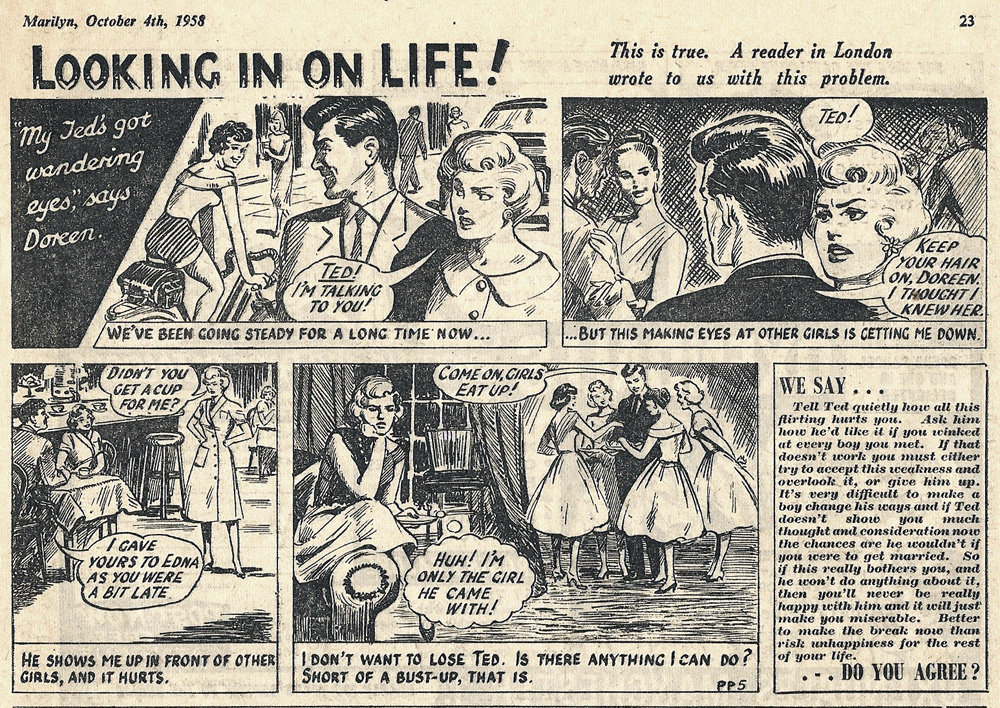
My advice, should anyone need it or even want it, is that Doreen should ditch Ted immediately. He’s disrespecting Doreen, so he’s not worthy of her respect. No second chances. Never take him back no matter how much he begs. That’ll show him.
The rest of the page is an ad for Miner’s cosmetics. One of the products here is something called “Cream Powder.” Now, I don’t know a huge amount about cosmetics but I do know that “Cream” and “Powder” are very different states of matter and it’s not really possible for a substance to exist in both states at the same time, so clearly there’s some sort of arcane quantum alchemy going on here.
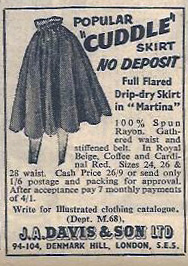 24. More ads.
24. More ads.
Including a half-page ad for the Oxendales catalogue, a quarter-pager for diamond rings from Cresta of Oxford St. (“As Televised” the ad boasts — always a sign of class, that), plus smaller ads for guitars, watches, dodgy-sounding “Escort Dance Lessons” and the popular “cuddle” skirt which we’re told is a full flared drip-dry skirt in “Martina.” I’ve no idea whether “Martina” is a fabric or a style, but I’m sure my big sister will know, given that that’s her name.
25-27. “Temper Temper” — comic strip
Another “Complete Marilyn Love Story.” Red-haired Molly Brown has returned from holiday in Southsea to see her boyfriend Ken kissing another girl. Naturally, because she’s a red-head and thus hot-tempered, Molly is furious about this, so when she confronts Ken she blurts out that she, too, has been seeing someone else: in Southsea she met a guy called Jim Best. This attempt to pour boiling oil on troubled waters has the expected effect: now they’re both furious. Thing is, though, Molly can’t admit that Jim Best never existed — she made him up. But soon word gets around town that Molly has been two-timing Ken and now her reputation is in tatters… And it gets worse when a very angry and hurt-looking girl arrives at the door and claims to be Jim Best’s girlfriend. It seems that young Molly is sinkable after all.
This one’s a bit too soap-opera/sitcom for my tastes: one of those stories where life would have been a lot easier for everyone concerned if someone actually listened to the character who says, “Let me explain…” And the artwork doesn’t gel, partly because the characters rarely seem to be looking at each other, only vaguely in each other’s direction, like this:
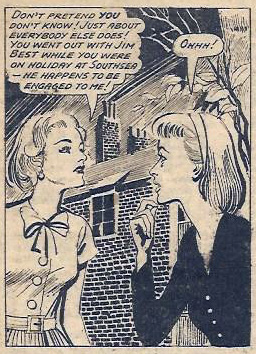
28. Ads
You can get a pinafore dress for only 4/ monthly over six months. I don’t fully understand pre-decimal currency, but by my calculations four shillings times six months comes to a total of eighteen guineas and a ha’porth of sugared tripe-drops from the door-to-door tin bath salesman.
More interesting is the coupon that accompanies the ad…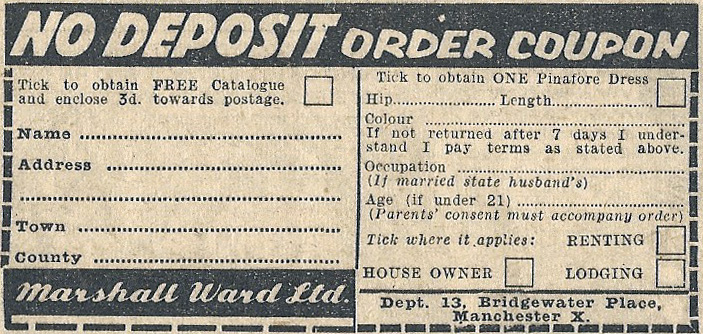
Note the lack of space for an e-mail address. Or a mobile number. Or even a landline. And while you’re noting that, take a close look at the right-hand side, about half-way up (or half-way down, depending on your mood). They say that the past is a different country… if so, then in that country they treat women as objects.
There’s also an ad for “Geo. Day’s Quickly Credit Service” which doesn’t sound massively suspicious at all, and another half-page of the seemingly eternal “Born for Each Other” story, continued from page 12.
29. “Sister, You Slay ‘Em!” — quiz
One of those multiple-choice quizzes. This one’s theme is, “Have You Got Poise?” After all, “Every girl needs poise if she’s going to be a hit.” The questions are all along the lines of, “You burst in on two people kissing. Do you: (a) Pretend you haven’t seen? (b) Apologise and stay? (c) Apologise and go out?” The best answers for each question earn the player five points, and you need thirty points or over to be judged to have “extremely good” poise.
The remainder of the page is the first side of a double-sided ad for the Littlewoods catalogue.
30. “Born for Each Other” — text story
Continued from page 28, and thankfully the last chunk for this issue. It’s followed by the coupon-side of the Littlewoods catalogue ad.
31. Short comic-strips
These are a bit rubbish, to be honest. One features kids complaining that TV shows feature “panels of teachers and professors” rather than panels of “cowboys and indians.” That’s it. That’s the entire gag. However, there’s also a wee puzzle in the form of a comic-strip:
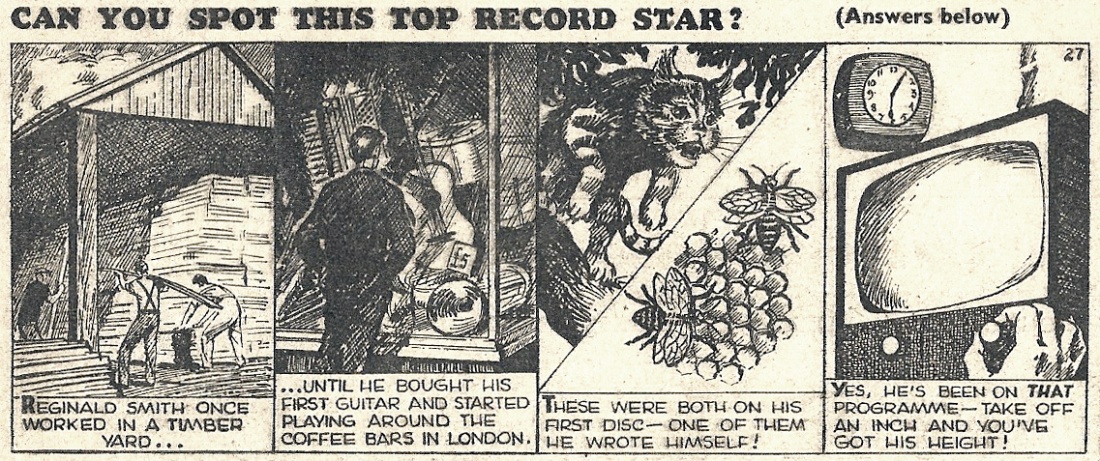
It’s not an easy one, so here are three hints:
1. If you’re a regular reader of Rusty Staples you’ll have a slightly better chance of working out the name of the mystery performer!
2. Remember Mrs Rusty’s list of heartthrobs way up there near the top of the columns?
3. The star’s first name was mentioned earlier in this column!
32. Ad: Cadbury’s Drinking Chocolate
The slogan in this ad — “What’s the time? It’s chocolate time!” — is of course redundant because it’s always chocolate time!
So, what’s Rusty’s verdict on this issue of Marilyn? Well, first, it’s pretty packed. You get quite a lot for your four pence. Comic strips, a prose chapter, a bunch of columns, lots and lots of neat opportunities to get yourself into debt with catalogues…
And second… Unsurprisingly none of the artists or writers in this issue are credited. I didn’t even spot a potential signature hidden away in the background. That’s typical for the era, but it still makes me sad.
Taken in the context of its era, and within its specific arena, Marilyn was a good, solid comic. Quality art and writing, and with a positive attitude.
These days there are lots of comics specifically aimed at young women (still not enough, though) but they’re very different to this. This is Bunty or Tammy aged-up long past the point at which women are expected to begin buying magazines instead, so from that aspect there is an almost innocent Pollyanna quality to the comic: romance is never more daring than holding hands or at most a kiss, true love always wins out, and while everyone looks to be somewhere around eighteen to twenty years old, they mostly behave like well-brought-up children playing at being adults.
This is a comic that seems to assume that women are in many ways just taller children with jobs that they’ll give up when they manage to marry a decent man. That’s how things often really were back then and we can’t blame a comic for reflecting the culture in which it existed, of course: but the comics with which I grew up, two decades after this one, railed against the establishment rather than doffed their hats to it.
Marilyn Monroe was in many ways very progressive for her time, almost subversive, and I can’t help wishing that her namesake comic had followed her along that path.
Ms Monroe died on August 4, 1962 at the far, far too young age of thirty-six. The comic ran for a further three years until it was absorbed by sibling romance title Valentine and became part of the My Guy family tree — a noble heritage!
Bonus:
Here’s the answer to the “Can You Spot This Top Record Star?” quiz:

You’re welcome!

You’re disappointed about the space time agents? For a second I thought it read Triffid Catalouge!
LikeLike
😀
The urge to seek out an old Trafford catalogue and do a bit of photoshoppery on it is now VERY strong!
LikeLike
Do it!
LikeLike
‘It’s Chocolate Time’ rang a bell with me as it was a slogan quoted in The Goon Show.
LikeLike